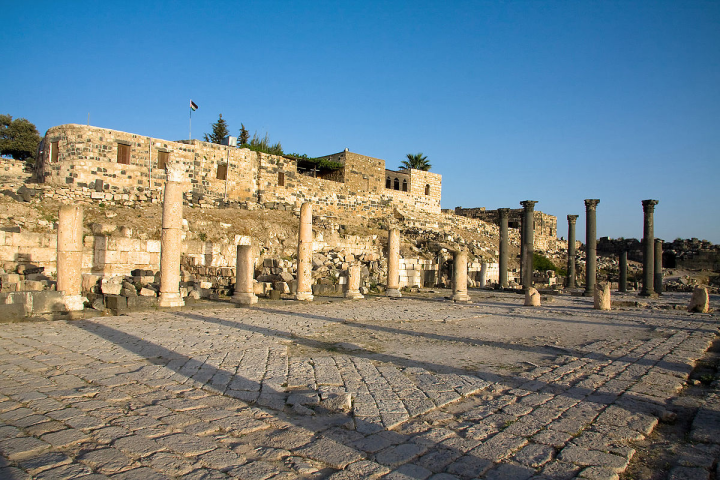Lenten Campaign 2025
This content is free of charge, as are all our articles.
Support us with a donation that is tax-deductible and enable us to continue to reach millions of readers.
Umm Qais marks the starting point of the Jordan Trail, an almost 700-kilometer-long hiking route that crosses Jordan from north to south. This northwestern town is home to the ruins of ancient Gadara, a city once known for being an important center of philosophical thought (mostly Cynical and Epicurean) but, mainly, for being the site of one of Jesus’ miracles: the Exorcism of the Gadarene Demoniac, also known as the Miracle of the Gadarene Swine, or the Exorcism of Legion.
Many visitors drive for about an hour to Umm Qais from the Jordanian capital, Amman, to visit the well-preserved ruins of the ancient Hellenistic city (the amphitheater, the cardo maximus, and the many still-standing ancient marbled columns) and enjoy its impressive panoramic views. From one of its many terraces, still paved with the original Greek and Roman cobblestones, one sees the Sea of Galilee, just across the valley of the Yarmouk River. It is from one of these terraces that Jesus commanded the demons tormenting a man to leave him and enter a herd of swine instead, according to three Synoptic Gospels. The swine, “numbering about two thousand” according to the Gospel of Mark (Cf. Mk 5, 13), “rushed down the steep bank into the sea, and were drowned in the sea.”

Any tourist guide will show the visitor the exact point where tradition holds the herd of swine began running down the hill, overlooking the sea where Jesus himself sailed. It is also the spot where the people found Jesus standing next to the man once possessed, now “clothed and in his right mind” (Cf. Mk 5, 15).
In a way, the preaching of the Gospel among the Gentiles began in Gadara, which was within the Decapolis (the league of ten ancient Hellenistic cities formed after the Roman conquest of the region). Some scholars, including N.T. Wright claim the first apostle to the Gentiles was not Paul, but the man who Jesus met in what is today the Jordanian northwest. “Go home to your [his] friends, and tell them how much the Lord has done for you, and what mercy he has shown you.”
Just a few miles south
Down the Dead Sea Road, not even an hour away from Amman, one reaches Al-Maghtas, the place officially known as Bethany Beyond the Jordan, Jesus’ Baptism site. This exceptional archaeological World Heritage site has traditionally been considered to be the original location where John the Baptist baptized Jesus, and has been venerated as such since, at the very least, the Byzantine period. Testimonies like those of Theodosius the Cenobiarch (an early monk, abbot, and saint), back what the Latin Patriarchate and UNESCO have unanimously claimed: that Bethany Beyond the Jordan is the place where John the Baptist baptized Jesus Christ. Theodosius’ text reads:
Although the pillar marking has not yet been discovered, the archaeological and architectural remains found in Al-Maghtas (meaning “immersion” and, by extension, “baptism” in Arabic) match Theodosius’ description. This is also the area in which John the Baptist, Jesus’ cousin, lived and ministered, and where tradition claims Elijah was assumed into Heaven. Like Gadara, the site is brimming with biblical references, traditions, and history. Not surprisingly, it is considered a particularly holy place for all Abrahamic religions —and for Christians in particular.

Just nine kilometers north of the Dead Sea (as in Theodosius’ description) the site consists of two distinctive areas. One of them, Jabar Mar-Elias (Arabic for “Elijah’s Hill”) is the place of Elijah’s Assumption. Since Scriptures say Elijah would return before the coming of the messiah, when John the Baptist began baptizing people in this very same place, villagers came to ask whether or not he was the messiah. One of the many caves found near Elijah’s Hill is said to be the one in which John himself lived.
The other area, in which we find the church of St. John the Baptist, right by the river, is the baptism site itself. This is the place where archaeologists found the ruins of a major Byzantine church and monastery, built during the reign of Emperor Anastasius (491-518), and where pilgrims from all over the world come to see the place where the Gospels claim that, after Jesus came out of the water, “the heavens were opened to him and he saw the Spirit of God descending like a dove and alighting on him. And a voice from heaven said, ‘This is my Son, the Beloved, with whom I am well pleased.’” (Cf. Mt 3, 16-17).
Make sure to visit the slideshow below to discover 10 ancient pilgrimage places you can visit in Jordan.











